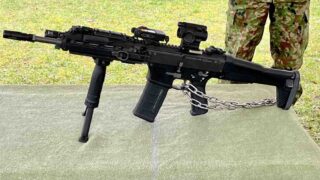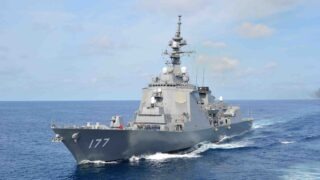JMSDF’s First CEC Ship
Currently, Japan’s Maritime Self-Defense Force (JMSDF) operates a total of eight Aegis destroyers mostly aimed at intercepting incoming ballistic missiles.
Among these Japanese Aegis warships, which is actually the world’s second largest Aegis fleet, the two “Maya-Class” destroyers are the latest batch, being commissioned in 2020.
With their arrival, the JMSDF has been able to allocate at least two Aegis destroyers to each of the four main fleets.
- General Overview
| Displacement | 8,200 tons (standard) |
| Length | 170m (557.7ft) |
| Beam | 21m (69ft) |
| Crew | 300 people |
| Speed | 30 knots (55.5km/h, 34.4mph) |
| Armament | 5 Inch Naval Gun×1 20mm CIWS×2 Anti-Ship Missiles×8 Vertical Launch System×96 Triple-Tube Torpedo×2 |
| Aircraft | SH-60 Helicopter×1 |
| Unit Price | 1.5 Billion USD |
The Maya-class is the third batch of Aegis warships following the Kongo-class and Atago-class, and were built as successors to the long-serving Hatakaze-class destroyers.
Both ships inherit their names from the Imperial Japanese Navy’s heavy cruisers, with “Maya” being particularly fitting for an Aegis warship due to the former cruiser’s reputation as an “anti-aircraft cruiser.”
The Maya-class features the latest “Baseline 9” version of the Aegis Combat System and the “BMD 5.1” Aegis Ballistic Missile Defense system, allowing for integrated operations from the outset.
Unlike previous Aegis ships that had to switch systems between air-defense and anti-ballistic missile operations, the BMD 5.1 system enables the Maya-class to simultaneously engage in both such missions.
But, the most notable point is that the Maya-class is the first JMSDF ship to be equipped with Cooperative Engagement Capabilities (CEC), a real-time sensor network system that provides high quality situational awareness and integrated fire control.
In other words, the CEC is a sophisticated system that shares radar and identification, sensor data on air targets amongst friendlies, making a more team-based approach available during combat.
For instance, if a patrol aircraft spots an enemy aircraft, it can share this information with a fellow Aegis ship, thus allowing the warship to intercept even if its own radar has not yet detected the target.
While information sharing itself is not something new, CEC stands out in its continuous, real-time sharing of large volumes of data compared to conventional datalink systems.
Adding to this central role in network-based combat, the JMSDF can expect smoother coordination with its allies, such as the US navy and Australian navy, by achieving integration through the CEC system.
Hence, the Maya-class is not only considered as vital for enhancing Japan’s naval capabilities, but also for promoting cooperation between likeminded allies in preparation for a future conflict with China.
Other Armament
While most of the focus goes to the Aegis’s system’s air-defense capacity, the Maya-class has actually improved its anti-ship capabilities as well, with the equipment of new “Type 17 anti-ship missiles.”
Moreover, the ships are to be installed with the latest SM-6 missiles, a long-range anti-air missile that can also be used for striking enemy surface vessels.
On the other hand, the Maya-class has dropped the counter-torpedo decoys which were found on the earlier Atago-class, but has maintained overall anti-submarine capabilities by adopting the cutting-edge Type 12 torpedos.




















Comments